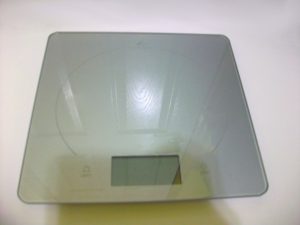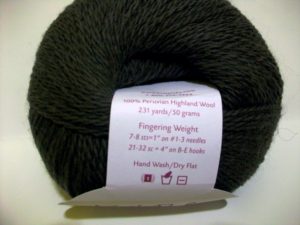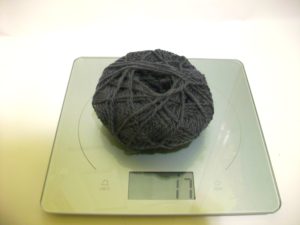How to Estimate Yarn Lengths
By Candace – 2 CommentsNow that I have a scale that measures small amounts, I can figure out how much yarn I’ve used and how much yarn I have left, and if you have one you can, too. It’s pretty easy, and it will help when it’s time to plan projects using unfinished skeins. It can also help if you’re breaking up a huge skein and winding it into more manageable balls. All you need is a kitchen scale and some basic math.

Kitchen scales can be pretty inexpensive. Even electronic ones can cost less than $10. Mechanical ones are even cheaper.
To do this, you will need to set up a length-to weight (or weight-to-length–it doesn’t matter as long as you’re consistent) proportion. You need to know three things: the weight of a full skein, the length of a full skein, and the weight of your partial skein. The first two should be printed on the label. If you’ve lost the label but know the yarn, check Ravelry, the manufacturer’s site, or a site that sells that particular yarn to find that information. (Note: if you’re on Ravelry, then just use your stash page, put in the weight you have left, and the site will calculate the length for you.)
The proportion will be set up as:
full length / full weight = partial length / partial weight
For my example, I’m using a ball of KnitPicks Palette. The band lists a full ball as 231 yards and 50 grams.

Remember to give your scale time to settle on a number. My partial ball weighs 17 grams.

So I’m left with 231 yards / 50 grams = x yards / 17 grams. That works out to a result of almost 79 yards. If you want to know how many yards you’ve used simply subtract your result from the total (for that ball, it’s about 152 yards).
And that’s it! Again, this is only an approximation. There are many factors that make it hard to get an exact number. Questions? Feel free to leave a comment below.


Do you ever weigh your full skein before you start? I’ve often found that they can be slightly off depending on the brand. It depends on how accurate you need to be, though.
Yes I do, especially my handspun, since I tend to not end up with the whole braid or batt in my finished product.
It’s a good idea to weigh your commercial yarn and fiber beforehand because factors like difference in humidity can change the weight between the mill and your home.